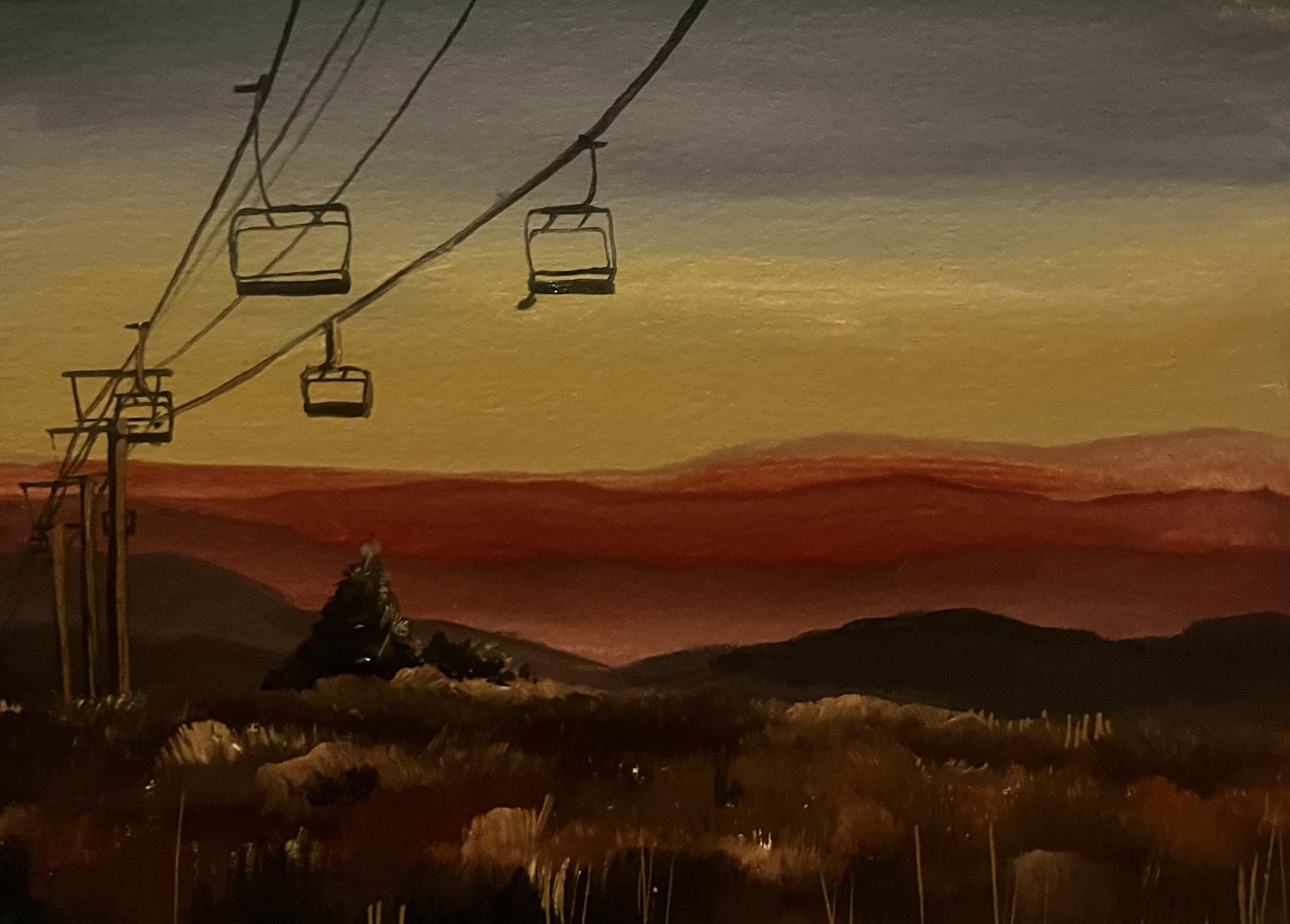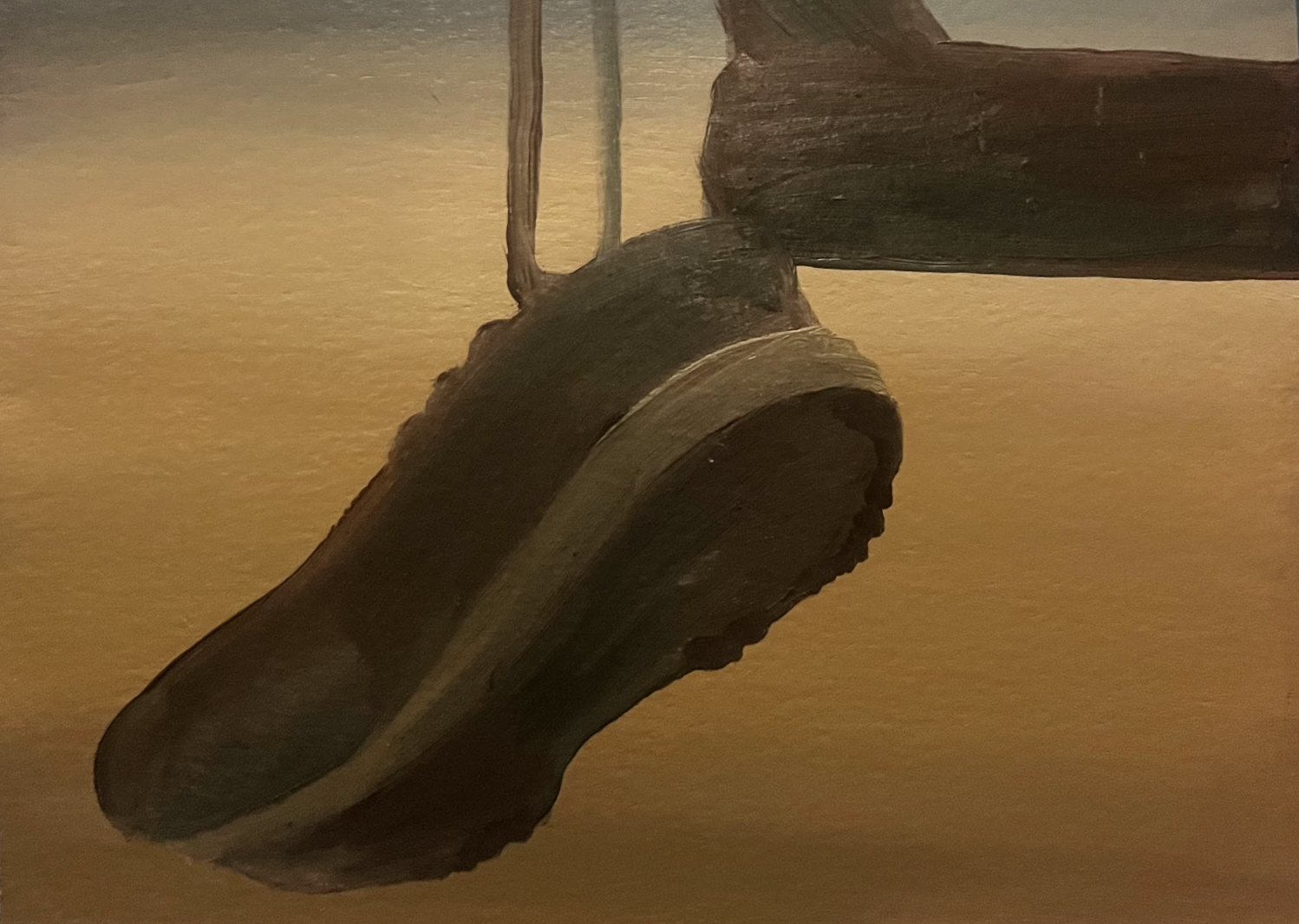Carcasses of the West
Matt Letourneau
Cozette Weng
Those old mine shafts out East Fork? Sure, I’ve been there. Boomtown, they called it [1]. I’ve trod through the caves, tottered on the crooked beams, thumbed the grain of those crumbling carts, the chutes, the cast-away tools. I’ve seen the machines, their gears rusted and stuck to pipes and levers like a rotten buffalo carcass. And, oh ‘em rails! Tarnished tracks, poking up from gravel, resting on bone-dry planks, splintering and gray. They’d disappear into a shaft and emerge from the mountain on stilted beams that’d chase you meters into the air. I heard these half collapsed bridges once freighted that shining, black ore that so many died for — silver, the very same in your belt buckle [2]. Browned spikes and decrepit fastenings hid underneath these wooden skeletons: relics from a time when men pushed carts through desolate mountains. A time when the sounds of pickaxe against rock, gear against gear, and rail against wheel echoed through the hollow hills.
Nowadays, ‘em mine shafts are chained shut. Silver in southern Idaho ran dry. Fetid, orange water forms fords around the mine’s adits, and old tools are swallowed by their taluses. But if you scramble up those cliffs, you’ll see “1952” inscribed on cracked stone above a shaft, chipped into the unrelenting rock for generations to bear [3]. A reminder. The desert has granulated those mines like the porphyry it produced. But I reckon these reliquaries will stand long after our bones embrace the land’s bistre tombs. Tso'appeh.
I’m telling you, ‘em arid badlands will ravage even the most callous of creatures. A wandering rattler is a customary reception up there. The sound of her maraca tail is a baptism for the unestablished. As an orange sun seeped from the oily meridian into the cracked ground, I noticed such a beast lingering beneath a sagebrush. Staggering backwards in a sidewise sort of line-dance, my boots startled a sandstorm. Scraping, scrambling, I closed my eyes. Yet I was greeted with neither hiss nor rattle. Dust settled, and my delusion was unearthed. No scaly demon rested beneath the dry brush. All that existed was a shedded shell, shriveled and shrunk. Our time was too late to cross paths. She was a traveler like me, slithering across the plains. Perhaps she is still exploring, hunting, or nesting. Maybe an unfortunate hiker can hear her rattle as we speak. Or maybe her bones are as dry as her molt. Years may have dripped through pores in volcanic rocks. Rivers may have flooded and settled. But she may still be traversing somewhere, anywhere, across these seamy cliffs.
I reckon she roamed southwise, maybe all the way to those vestiges that haunt Croy Canyon. Oh, you’ve never heard of the old homes left to wither? No, not a town, nor desolate ranches. Just sparse cabins concealed in pines and aspens. Not many know about ‘em. Even less know their purpose. The families that used to live there are now only whispers in the desert. I discovered one of the canyon’s treasures by fate. Its shingles were sunbleached and its chimney sank into the caving roof. Green flakes hung onto the porch’s columns: a painter’s long lost work. We didn’t want to go inside the wooden wreckage, but it felt necessary. Stepping into that dreary monument, my fellow wanderers and I flicked on our flashlights. There were still pans on the collapsing counter, still bones in the fly-infested fridge. A dead man’s bed frame laid dormant in the corner. Without thinking, I sat upon it as if it were a decaying throne. That’s when the whole place started to spin. Puha yaami'a.
I’m telling you, that cabin disfigured in front of my eyes! Shifting, shaking, and arching until it was resurrected. A stranger stepped through the creaking, wooden door. His clothes were tattered and black, his face scruffy and tired. He took a beer from the pristine, white fridge and sat on a cushioned chair in the corner that had been a pile of planks. The walls held paintings of grazing bison on the great Sawtooth range, and the dining room table no longer had three legs. Then, as quickly as this vision appeared, it was extinguished. The spinning slowed, the miner evaporated, and the walls melted back into disarray. No more bison, no more mountains. I emerged from my thoughts, and there I was on that creaking bed frame. The wind whistled through holes in the facade, and the cabin was the same. It was changed only by time. Who knows whose lives that place has affected? Who knows who lived here? A miner, a farmer, a family? It was inconsequential. Now it stands neglected, another dilapidated shack consumed by a canyon.
I’ve seen dozens of ‘em. They take on their own personality. Some are castles and some are ruins. But I reckon that most are a means to experience something more than yourself. As I always say, you can see the most breathtaking view of my Sun Valley, my hometown, from the abandoned ski lift perched atop Proctor Mountain. The cables are mangled and the chairs are slowly descending onto the brush and pines below. Whenever I gaze at this machine from the road, it looks like it's still towing tourists up for a snowy joyride. But, this chairlift is a veteran. In fact, it’s the oldest ever built. I’ve traversed the rocks and trudged through the prickly pears. The elk have watched as I’ve climbed the rusted scaffolding and clambered up the splintered wood. I like to stand on top of the old pulleys and wheels: climb to the highest point I can. When the wind blows your hair up there, your eyes can’t help but wander. Glistening rivers flow through canyons, green forests extend beyond your sight. Jagged cliffs and pointed slopes poke above the horizon. It’s all there. It’s all there. Ko'ih.
I never search for the discarded. I just stumble upon ‘em. Driving for hours on dirt roads, hiking on an ancient trail, spotting enigmatic monuments on the street corner when I stroll through town. Their stories are rich. Their lives are filled with characters and conflicts. They used to be glorious, or they used to be dreary. But they will never disappear. Wildfires are common in these high deserts. Whenever fire strikes, a world turns to ash. Sure, I’ve seen it: a once vibrant forest turned black as the night sky. But I’ve also discovered what fire brings. From the decay and ruin comes new life. Months pass, and green begins to invade. Years go by, and dozens of saplings sprout from the burnt ground. Decades pass and the forest becomes more lush, teeming with more diverse flowers and animals, than it ever was before. A demolished building will sprout two more. Another snake will shed its skin. Miners come and go. Lives start and end. Fortresses are erected and then destroyed. Who’s to say where the next one will be? As long as I see these memorials of rust and splinters, their forgotten stories will always haunt me. They are the past from which we can never dance away. Tuattsi'a.
References
[1] Stahl, Jennifer. “Boomtown - Lead, Gold & Silver, Oh My!” Valley Chamber, Discover WRV, 25 May 2022, valleychamber.org/idaho-mines/. [2] “Triumph Silver Mine - Triumph, ID.” Minespotter, 3 Nov. 2018, www.minespotter.com/triumph-silver-mine-triumph-id/.[3] ibid.[4] “Surprising Railroad Inventions: The Ski Lift.” Union Pacific, 3 Dec. 2019, www.up.com/customers/track-record/tr071719-ski-lift.htm#:~:text=In%20December%20of%201936%2C%20Union,sport%20of%20snow%20skiing%20forever
Artist’s Statement
Stories can be found anywhere, even in the dilapidated and forgotten. Growing up in Idaho, I felt isolated, confined to the small ski town I had grown up in. But, at the same time, I felt like the whole world was at my fingertips. The great western expanse was my backyard, its rivers my playground and its mountain ranges my school. Therefore, with little else to do, my friends and I entertained ourselves in the only way we knew how: exploration.
From discovering the abandoned hut in Croy Canyon to getting scared by rattlesnake skin, I explore some of my adventures in the area surrounding my hometown. Although I don’t use my own voice for the narration, I depict my experiences as accurately as I can remember, and I weave these memories with supporting research into the region and its history.
Abandoned places are everywhere, and it seems the farther out you traverse in the high desert, the more strange and beautiful things you see. When I saw these enigmas, they can’t help but wonder what influence they had on the past, whose lives they impacted, and why they are there in the first place. The history of these objects is our history. My hometown would be a completely different place if that ski lift were never constructed or if those miners never found silver.
We live in a different world than the one that these abandoned places thrived in. The American Bison once grazed wild over southeast Idaho. Now they are only found in specific regions or on farms. The full glory of their world no longer exists, just like the world of the Native Americans who once hunted them — the Shoshone, Bannock, Nez Perce, and other peoples. The land that I explored was taken from these tribes over a century ago in bloody campaigns and deceptive tactics. To honor those who trekked Idaho’s mountains before me, and to illustrate how a place’s past can haunt us, I included whispers of Shoshoni words from the Duck Valley region that correlate with specific parts of the story.
While writing, I took inspiration from western novels like Cormac McCarthy’s Blood Meridian and music such as the albums Yours, Dreamily, by The Arcs and El Bueno Y El Muelo by Hermanos Gutiérrez. The arid west has a mood, a feeling invoked by imagery on the same plane as cowboys and horses. Growing up there, this feeling coats your skin like dust blowing in the dry air. I originally intended to use my own voice in narration, but by studying how writers, like McCarthy, encapsulate the essence of the west through characters and dialogue, I knew that my narration was the key to accurately creating this feeling for readers. I intended the reader to feel like they are sitting across a campfire with a through hiker or a seasoned mountain man, and to pass the time, he shares wisdom and stories about his adventures in the desert.
The world is forever changing, and as it changes, things are left behind and forgotten. Just like how our memories and experiences telescope to form our identity, the world’s relics create its identity. We are our own experiences, our own past, our own history. But, at the same time, we are others’ experiences, others’ pasts, and others’ histories. Whether it's something as large as a mining town, or something as small as sagebrush, everything will come and go. When our bones sink into the desert’s bistre tombs only our remains and our memories will exist.

